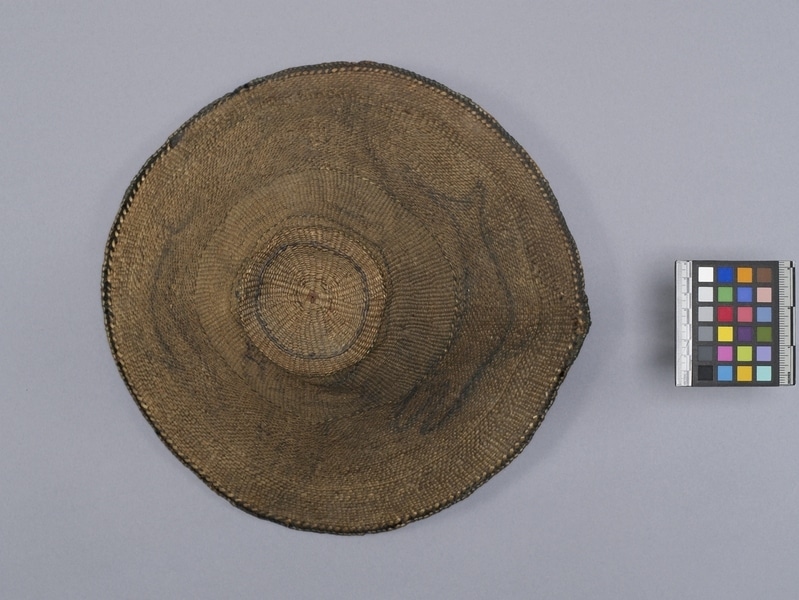Hat Item Number: A3239 from the MOA: University of British Columbia




Description
Basketry hat with painted designs and a flared brim. The warps are made of red cedar bark and a small square of checkerboard plaiting is present at the top. The hat is woven of triangle sedge grass, using double strand twining. The warps are divided after several rows and the weaving becomes finer. Green-dyed grass has been used in several areas as an accent combined with the use of three strand twining. The painted design is of a male figure with hands upraised, flanked on either side by fish or whale figures. The paint is a dark green colour and badly faded. The rim of the hat is finished with dyed grass and a black yarn-like material. The hat has a cap-shaped liner woven into its interior. The liner is diagonally twined.
Specific Techniques
Two strand and three strand twining were used for this hat. In two strand twining one weft strand passes over the warp while the other passes under, so that the wefts are always in opposition to each other. Three strand twining is similar execept that the weaver begins with three weft strands that are seperated from each other by a warp. The weft that is furthest to the left is passed over two warps and then under one. The pattern continues with the next weft strand.
Narrative
Over the years, this hat has been identified as being Nuu-chah-nulth, Coast Salish or Kwakwaka'wakw in style. In 2000, Sto:lo weaver Rena Point Bolton said she thought the human figure appeared to be stylistically Salish. In 2023 weaver William White said the hat appeared to be Tsimshian, and that it could have been made by Annie Green. Green's signature mark was a green circle inside at the top. The list kept by Buttimer, the collector, said the hat was collected along the Fraser River, but may have come from Cape Mudge? It's possible that information refers to another hat, A8345.
Item History
- Made in British Columbia, Canada before 1900
- Collected during 1900
- Owned by Margaret L. Buttimer
- Owned by Alfred J. Buttimer before 1932
- Received from Alfred J. Buttimer (Donor) during 1932
What
- Name
- Hat
- Identification Number
- A3239
- Type of Item
- hat
- Material
- cedar bark, sedge grass, paint and fibre
- Manufacturing Technique
- twined, painted, plaited, dyed and split
- Overall
- height 16.0 cm, diameter 34.6 cm
Who
- Culture
- Tsimshian ?
- Previous Owner
- Margaret L. Buttimer and Alfred J. Buttimer
- Received from
- Alfred J. Buttimer (Donor)
Where
- Holding Institution
- MOA: University of British Columbia
- Made in
- British Columbia, Canada
When
- Creation Date
- before 1900
- Collection Date
- during 1900
- Ownership Date
- before 1932
- Acquisition Date
- during 1932
Other
- Item Classes
- basketry
- Condition
- fair
- Accession Number
- 2003/0091